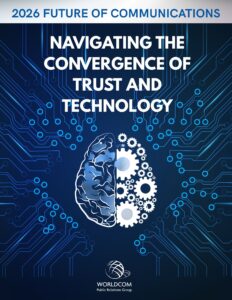The era of treating misinformation as an occasional crisis is over. In 2026, false narratives, deepfakes, and manipulated content won’t arrive as isolated incidents requiring reactive response—they will be an ambient condition of the communications environment, as predictable as algorithm changes and as persistent as brand competition.
AI’s Industrialization of Misinformation
Our partners describe a fundamental shift in how organizations must approach truth and verification. Artificial intelligence hasn’t just made misinformation easier to create—it has industrialized it. Deepfakes that once required specialized expertise and significant resources can now be generated in seconds.
Synthetic voices replicate real people with unsettling accuracy. Fabricated images and videos appear so convincing that even trained professionals struggle to identify manipulation. The tools that enable legitimate communications professionals to work more efficiently are the same tools bad actors use to undermine credibility at scale.
Rebuilding Trust
The implications are profound. As one partner bluntly observes: the defining challenge for PR in 2026 will be rebuilding trust when everything can be faked. Organizations can no longer simply manage their reputations through strategic messaging—they must actively defend truth itself. The question isn’t “What if misinformation hits us?” but “How fast can we respond when it does?”
Yet our partners also identify reasons for cautious optimism. The same technology enabling misinformation also enables detection, tracking, and rapid verification. Traditional legacy media is regaining importance as audiences seek trusted sources in a sea of synthetic content. And organizations that invest proactively in transparency, verification systems, and media literacy—both internally and with their audiences—can build resilience before crises emerge.
Monitoring Tools and Crisis Protocols
The response requires more than monitoring tools and crisis protocols. It demands what our partners call “truth architecture”: structural systems that authenticate content, verify sources, deploy factual counter-narratives in real time, and educate audiences before falsehoods gain traction. It requires building direct, trusted communication channels that bypass the noise. Most critically, it requires visible human presence—real spokespeople, verifiable credentials, transparent processes—as counterweights to synthetic sophistication.
What follows are candid assessments from partners managing these challenges across diverse regulatory environments, cultural contexts, and threat landscapes. They don’t offer simple solutions, because none exist. Instead, they provide frameworks for building organizational capacity to operate in an environment where misinformation is constant, detection is difficult, and trust must be earned through proof rather than promises.
Download the 2026 Predictions eBook
 You can download the 2026 Future of Communications eBook and get all of the insights from Worldcom PR Group Partners.
You can download the 2026 Future of Communications eBook and get all of the insights from Worldcom PR Group Partners.



